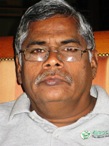Where we’ve come from, where we are, and where we’re going
Travel with Dave from the beginning – and before the beginning – of GCP, and how the Programme will be brought to an orderly close. Dave also elaborates on the role of the Consortium Committee.
There’s no doubt that the Programme has enabled new partnerships and rekindled and rejuvenated old or existing partnerships amongst the different partners. Some of these are between the different CGIAR Centres and others are between these Centres and partners outside the CGIAR. These partnerships have been very fruitful.
People speak of GCP almost as if it were the 16th Centre. They speak of it with pride and respect. They understand the important role it can play.
GCP has a lot of credibility with national programmes. When you go to GCP’s General Research Meetings, there’s clearly a feeling of being part of the community, and that we are all improving our efficiency because of the Programme.
…I think it’s been one of the more successful Challenge Programmes.
 Dave Hoisington (pictured) is the Chair of GCP’s Consortium Committee, and currently ICRISAT’s Director of Research. Dave was previously with CIMMYT, GCP’s host Centre. He has therefore been involved with GCP “since day minus one” in his words. “It’s equally exciting to be involved in the Programme’s closure, because I think that is even more important with regard to keeping its legacy alive.” Dave now walks us through the workings of the Programme today, its achievements and challenges, and what the early formative years were like….
Dave Hoisington (pictured) is the Chair of GCP’s Consortium Committee, and currently ICRISAT’s Director of Research. Dave was previously with CIMMYT, GCP’s host Centre. He has therefore been involved with GCP “since day minus one” in his words. “It’s equally exciting to be involved in the Programme’s closure, because I think that is even more important with regard to keeping its legacy alive.” Dave now walks us through the workings of the Programme today, its achievements and challenges, and what the early formative years were like….
What is the role of the GCP Consortium Committee?
GCP was set up as a multi-institutional endeavour. As an elaborate and broad partnership representing various interests, the decision at the Programme’s inception was to set up a committee representing all the key members from CGIAR Centres, developing-country programmes and advanced research institutes.
This Consortium Committee is ultimately the one that ‘owns’ GCP and oversees the basic functioning of the Programme to make sure that it is going in the right direction. We have an Executive Board which the Consortium appointed and it’s that Executive Board that Jean-Marcel [GCP Director] reports to. Because we set up the Board, they actually report to us.
…by having this Committee of the key players in research as well as an independent Board, we can all make sure GCP is going in the right direction, by giving voice to both the ‘players’ and ‘referees’.
Why have a Committee as well as a Board, and why seek broad partnerships?
During a mid-term review of GCP, the need for both a Committee and an independent Executive Board was recognised to give the Programme more structure and guidance. The Consortium Committee was established in 2008, and its precursor was the Programme Steering Committee.
GCP is not a research programme run by a single institute but really a consortium to enhance effectiveness. So, by having this Committee of the key players in research as well as an independent Board, we can all make sure GCP is going in the right direction, by giving voice to both the ‘players’ and ‘referees’.
There’s no doubt that the Programme has enabled new partnerships and rekindled and rejuvenated old or existing partnerships amongst the different partners. Some of these are between the different CGIAR Centres and others are between these Centres and partners outside the CGIAR. These partnerships have been very fruitful.
GCP’s tagline – ‘Partnerships in modern crop breeding for food security’ – what does this mean for you?
It really captures the essence of GCP – GCP is about creating opportunities for these partnerships. It’s about using a modern approach, a more integrated approach to breeding, to aid food security in the developing world.
Why is GCP’s work important?
The whole premise of setting up GCP 10 years ago was really the fact that our major crops were not registering the necessary increases in yield to meet food needs in developing countries. There are many reasons for that. The reason that became the main driving force for GCP was that we had not been able to tap the rich genetic diversity that exists for almost all of these crops. So the idea was to come up with mechanisms, methods, examples and proofs-of-concept that tap into this genetic diversity, and package it such that breeding programmes can integrate it into their operations. By so doing, we would broaden the horizon of breeding programmes for more rapid gains in yields and productivity in farmers’ fields.
Originally, the whole idea was mostly a proof-of-concept. Once we realised it could work, we realised that capacity needed to be built within national programmes since GCP’s scope was 10 years. So, the emphasis began to rightly shift from exploration and discovery to application and impact, buttressed by more training and capacity building within national programmes for sustainability. Genetic research was – and still remains – the backbone, but there has been a growing reliance on other tools including IT and molecular breeding. Now the technology has matured, costs have decreased, making it more viable for public research.
Unfortunately, we don’t have the alternative case of what it would have been like without GCP… but I think that many institutes within and outside CGIAR are trying to use genomics as a technology, and I think a lot of that can be traced back to projects that GCP supported.
What have been the major outcomes of GCP so far?
The greatest overall outcome is a stronger awareness and use of genomics in our research programmes across the board.
Unfortunately, we don’t have the alternative case of what it would have been like without GCP, which we could compare to, but I think that many institutes within and outside CGIAR are trying to use genomics as a technology, and I think a lot of that can be traced back to projects that GCP supported and encouraged.
In the early years, characterisation of genetic resources was very beneficial and it’s encouraging to see it still continues, with characterising genetic resources now considered routine.
What outcomes are you most looking forward to?
I think one of the most promising, and potentially important outcomes will be the adoption of GCP’s Integrating Breeding Platform.
‘Challenge’ is in GCP’s name. What are the major challenges that the Programme has so far overcome?
When GCP was being designed, there was no definition or case study for what a Challenge Programme had to do. The preliminary idea was that for projects to succeed and overcome major challenges, partnerships were key and no single institute could do it alone: they needed to do business differently, whether among the CGIAR Centres, or with partners outside the CGIAR. We had all these genebanks, all this diversity, genetic and genomic tools for some crops but not all crops. So, we put our heads together and asked ourselves, “What if we combine these modern molecular approaches used in one crop and apply them to another crop? Can we unlock the genetic diversity within it to improve quality and yield? How do we get all partners to work together towards a common goal?”
At the beginning, GCP had probably way too many facets and we were trying to move ahead on all the different fronts, so I think the mid-term reshaping and redefinition of the Programme helped it gain more focus to actually do what it set out to do.
GCP has built capacity, tools, methodologies and technologies. All these need to continue so as to increase and improve outputs and enhance outcomes.
What future challenges must the Programme overcome to remain sustainable?
Ensuring its achievements are sustained. While it was a time-bound programme from day one, the results and successes are not time-bound. They should be sustained and continued in other shapes and forms.
The challenge now is filtering these successes and figuring out how best to continue them. GCP has built capacity, tools, methodologies and technologies. All these need to continue so as to increase and improve outputs and enhance outcomes.
What are the main lessons learnt so far?
Partnerships are not easy. They take a lot of time. It’s one thing to write a proposal and say we will work together but it’s another thing to make that work effectively. I know GCP has had some instances where partners brought in have not been effective. I’m sure the GCP management has learnt lessons on how to deal with that.
People work together because they trust and respect one another and recognise and understand each other’s roles. They don’t view it as a competition. Some partnerships occur spontaneously, while others take time. They have to build trust, understanding and communication.
We’ve all learnt lessons from the research side, such as what does and doesn’t work. Focussing was a good lesson that GCP and all of us have learnt. At the beginning, we just spread ourselves too thin, trying to do too many things, making it very difficult to measure progress.
What is the most enjoyable aspect of your involvement with GCP?
I’ve been involved in GCP from day minus one. I used to be at CIMMYT and was involved in the ‘pre-pre-birth’ of the Programme, even before it had been conceptualised. Through the years since then, I’ve had different levels of engagement – and even periods of disengagement – but have always enjoyed my involvement.
It’s always been a good group of people working together, even when there have been problems. I think the Programme has scored high on successes. Jean-Marcel and his team deserve a lot of credit. They’ve really been able to keep the momentum going.
It’s equally exciting to be involved in the Programme’s closure, because I think that is even more important with regard to keeping its legacy alive.
People speak of GCP almost as if it were the 16th Centre. They speak of it with pride and respect. They understand the important role it can play.
GCP has a lot of credibility with national programmes… Ithink it’s been one of the more successful Challenge Programmes.
Jean-Marcel talks of the ‘GCP spirit’ and how successful partners share this spirit. What are your thoughts on this?
GCP definitely has a strong ‘entity’, although I’m not sure if this is a spirit! People speak of GCP almost as if it were the 16th Centre. They speak of it with pride and respect. They understand the important role it can play.
GCP has a lot of credibility with national programmes. When you go to GCP’s General Research Meetings, there’s clearly a feeling of being part of the community, and that we are all improving our efficiency because of the Programme.
I think it’s been one of the more successful Challenge Programmes.
Relevant links
- Consortium Committee and Executive Board
- Integrated Breeding Platform website
- Transition Strategy, 2010 (GCP in CGIAR reform, and closing GCP)
- External Programme and Management Review, 2008 (commissioned by CGIAR)
- CGIAR Challenge Programmes




















